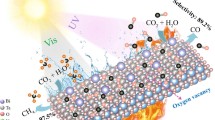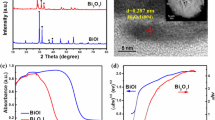Abstract
Heterogeneous photosynthesis is a promising route for sustainable ammonia production, which can utilize renewable energy and water as the hydrogen source under ambient condition. In this study, a series of Bi5O7I (BOI) nanosheets and nanotubes are synthesized, and the surface tensile strain is formed by curling the nanosheets into nanotubes to tune the concentration and location of dynamic vacancies. Scanning transmission electron microscopy (STEM) with spherical aberration correction confirms the presence of intrinsic areal defects on the surface of the BOI nanotube resulted from surface tensile strain. The presence of areal defects lowers the formation energy of I vacancies (IV) at step edge site, thus the IV with higher concentration would be favorably generated under visible light. Rapid scan in situ Fourier transform infrared (FT-IR) analysis in the aqueous media reveals that the IV promotes photocatalytic N2 activation and reduction, and proceeds through an associative alternating mechanism. Specially, after turning off the light, the surface vacancy sites can be reoccupied by I− ions, which enables the protection and regeneration of photocatalyst surface in an aerobic and dark environment. This work provides an innovative strategy to tune concentration and location of dynamic surface vacancies on photocatalysts by building surface tensile strain for advancing sustainable ammonia production.

Similar content being viewed by others
References
Spatzal, T.; Perez, K. A.; Einsle, O.; Howard, J. B.; Rees, D. C. Ligand binding to the FeMo-cofactor: Structures of CO-bound and reactivated nitrogenase. Science 2014, 345, 1620–1623.
Lan, R.; Irvine, J. T. S.; Tao, S. W. Ammonia and related chemicals as potential indirect hydrogen storage materials. Int. J. Hydrogen Energy 2012, 37, 1482–1494.
Brown, K. A.; Harris, D. F.; Wilker, M. B.; Rasmussen, A.; Khadka, N.; Hamby, H.; Keable, S.; Dukovic, G.; Peters, J. W.; Seefeldt, L. C. et al. Light-driven dinitrogen reduction catalyzed by a CdS: nitrogenase MoFe protein biohybrid. Science 2016, 352, 448–450.
Hoffman, B. M.; Lukoyanov, D.; Yang, Z. Y.; Dean, D. R.; Seefeldt, L. C. Mechanism of nitrogen fixation by nitrogenase: The next stage. Chem. Rev. 2014, 114, 4041–4062.
Rosca, V.; Duca, M.; De Groot, M. T.; Koper, M. T. M. Nitrogen cycle electrocatalysis. Chem. Rev. 2009, 109, 2209–2244.
Kitano, M.; Inoue, Y.; Yamazaki, Y.; Hayashi, F.; Kanbara, S.; Matsuishi, S.; Yokoyama, T.; Kim, S. W.; Hara, M.; Hosono, H. Ammonia synthesis using a stable electride as an electron donor and reversible hydrogen store. Nat. Chem. 2012, 4, 934–940.
Kuriyama, S.; Arashiba, K.; Nakajima, K.; Matsuo, Y.; Tanaka, H.; Ishii, K.; Yoshizawa, K.; Nishibayashi, Y. Catalytic transformation of dinitrogen into ammonia and hydrazine by iron-dinitrogen complexes bearing pincer ligand. Nat. Commun. 2016, 7, 12181.
Ali, M.; Zhou, F. L.; Chen, K.; Kotzur, C.; Xiao, C. L.; Bourgeois, L.; Zhang, X. Y.; MacFarlane, D. R. Nanostructured photoelectrochemical solar cell for nitrogen reduction using plasmon-enhanced black silicon. Nat. Commun. 2016, 7, 11335.
Lu, Y. H.; Yang, Y.; Zhang, T. F.; Ge, Z.; Chang, H. C.; Xiao, P. S.; Xie, Y. Y.; Hua, L.; Li, Q. Y.; Li, H. Y. et al. Photoprompted hot electrons from bulk cross-linked graphene materials and their efficient catalysis for atmospheric ammonia synthesis. ACS Nano 2016, 10, 10507–10515.
Guo, C. X.; Ran, J. R.; Vasileff, A.; Qiao, S. Z. Rational design of electrocatalysts and photo(electro)catalysts for nitrogen reduction to ammonia (NH3) under ambient conditions. Energy Environ. Sci. 2018, 11, 45–56.
Chen, G. F.; Cao, X. R.; Wu, S. Q.; Zeng, X. Y.; Ding, L. X.; Zhu, M.; Wang, H. H. Ammonia electrosynthesis with high selectivity under ambient conditions via a Li+ incorporation strategy. J. Am. Chem. Soc. 2017, 139, 9771–9774.
Nishibayashi, Y. Recent progress in transition-metal-catalyzed reduction of molecular dinitrogen under ambient reaction conditions. Inorg. Chem. 2015, 54, 9234–9247.
Lai, F. L.; Feng, J. R.; Ye, X. B.; Zong, W.; He, G. J.; Yang, C.; Wang, W.; Miao, Y. E.; Pan, B. C.; Yan, W. S. et al. Oxygen vacancy engineering in spinel-structured nanosheet wrapped hollow polyhedra for electrochemical nitrogen fixation under ambient conditions. J. Mater. Chem. A 2020, 8, 1652–1659.
Shi, M. M.; Bao, D.; Wulan, B. R.; Li, Y. H.; Zhang, Y. F.; Yan, J. M.; Jiang, Q. Au sub-nanoclusters on TiO2 toward highly efficient and selective electrocatalyst for N2 conversion to NH3 at ambient conditions. Adv. Mater. 2017, 29, 1606550.
Licht, S.; Cui, B. C.; Wang, B. H.; Li, F. F.; Lau, J.; Liu, S. Z. Ammonia synthesis by N2 and steam electrolysis in molten hydroxide suspensions of nanoscale Fe2O3. Science 2014, 345, 637–640.
Jacobsen, C. J. H.; Dahl, S.; Clausen, B. S.; Bahn, S.; Logadottir, A.; Nørskov, J. K. Catalyst design by interpolation in the periodic table: Bimetallic ammonia synthesis catalysts. J. Am. Chem. Soc. 2001, 123, 8404–8405.
Jin, H. Y.; Guo, C. X.; Liu, X.; Liu, J. L.; Vasileff, A.; Jiao, Y.; Zheng, Y.; Qiao, S. Z. Emerging two-dimensional nanomaterials for electrocatalysis. Chem. Rev 2018, 118, 6337–6408.
Xiong, L. J.; Hu, Y. J.; Yang, Y.; Deng, Q. H.; Tang, Z.; Li, P. J.; Shen, J. Y.; Zhang, X. Y.; Wang, T. Y.; Xu, X. Y. et al. Electron pump strengthened facet engineering: Organic half-metallic C(CN)3 enclosed (100) facet exposed WO3 for efficient and selective photocatalytic nitrogen fixation. Appl. Catal. B: Environ. 2022, 317, 121660.
Tang, Z.; Xiong, L. J.; Zhang, X. Y.; Shen, J. Y.; Sun, A. W.; Lin, X. Y.; Yang, Y. Biomass-induced diphasic carbon decoration for carbon nitride: Band and electronic engineering targeting efficient N2 photofixation. Small 2022, 18, 2105217.
Gao, X.; An, L.; Qu, D.; Jiang, W. S.; Chai, Y. X.; Sun, S. R.; Liu, X. Y.; Sun, Z. C. Enhanced photocatalytic N2 fixation by promoting N2 adsorption with a co-catalyst. Sci. Bull. 2019, 64, 918–925.
Wang, L.; Zhao, X.; Lv, D. D.; Liu, C. W.; Lai, W. H.; Sun, C. Y.; Su, Z. M.; Xu, X.; Hao, W. C.; Dou, S. X. et al. Promoted photocharge separation in 2D lateral epitaxial heterostructure for visible-light-driven CO2 photoreduction. Adv. Mater. 2020, 32, 2004311.
Qiu, P. Y.; Wang, J. W.; Liang, Z. Q.; Xue, Y. J.; Zhou, Y. L.; Zhang, X. L.; Cui, H. Z.; Cheng, G. Q.; Tian, J. The metallic 1T-WS2 as cocatalysts for promoting photocatalytic N2 fixation performance of Bi5O7Br nanosheets. Chin. Chem. Lett. 2021, 32, 3501–3504.
Wu, X. L.; Ng, Y. H.; Wang, L.; Du, Y.; Dou, S. X.; Amal, R.; Scott, J. Improving the photo-oxidative capability of BiOBr via crystal facet engineering. J. Mater. Chem. A 2017, 5, 8117–8124.
Dong, X. A.; Cui, Z. H.; Shi, X.; Yan, P.; Wang, Z. M.; Co, A. C.; Dong, F. Insights into dynamic surface bromide sites in Bi4O5Br2 for sustainable N2 photofixation. Angew. Chem., Int. Ed. 2022, 61, e202200937.
Shi, X.; Dong, X. A.; He, Y.; Yan, P.; Zhang, S. H.; Dong, F. Photoswitchable chlorine vacancies in ultrathin Bi4O5Cl2 for selective CO2 photoreduction. ACS Catal. 2022, 12, 3965–3973.
Shi, X.; Dong, X. A.; He, Y.; Yan, P.; Dong, F. Light-induced halogen defects as dynamic active sites for CO2 photoreduction to CO with 100% selectivity. Sci. Bull. 2022, 67, 1137–1144.
Mao, C. L.; Cheng, H. G.; Tian, H.; Li, H.; Xiao, W. J.; Xu, H.; Zhao, J. C.; Zhang, L. Z. Visible light driven selective oxidation of amines to imines with BiOCl: Does oxygen vacancy concentration matter? Appl. Catal. B: Environ. 2018, 228, 87–96.
Pacchioni, G. Oxygen vacancy: The invisible agent on oxide surfaces. ChemPhysChem 2003, 4, 1041–1047.
Ganduglia-Pirovano, M. V.; Hofmann, A.; Sauer, J. Oxygen vacancies in transition metal and rare earth oxides: Current state of understanding and remaining challenges. Surf. Sci. Rep. 2007, 62, 219–270.
Luo, M. C.; Zhao, Z. L.; Zhang, Y. L.; Sun, Y. J.; Xing, Y.; Lv, F.; Yang, Y.; Zhang, X.; Hwang, S.; Qin, Y. N. et al. PdMo bimetallene for oxygen reduction catalysis. Nature 2019, 574, 81–85.
Xia, Z. H.; Guo, S. J. Strain engineering of metal-based nanomaterials for energy electrocatalysis. Chem. Soc. Rev. 2019, 48, 3265–3278.
Di, J.; Song, P.; Zhu, C.; Chen, C.; Xiong, J.; Duan, M. L.; Long, R.; Zhou, W. Q.; Xu, M. Z.; Kang, L. X. et al. Strain-engineering of Bi12O17Br2 nanotubes for boosting photocatalytic CO2 reduction. ACS Mater. Lett. 2020, 2, 1025–1032.
Zhu, H.; Gao, G. H.; Du, M. L.; Zhou, J. H.; Wang, K.; Wu, W. B.; Chen, X.; Li, Y.; Ma, P. M.; Dong, W. F. et al. Atomic-scale core/shell structure engineering induces precise tensile strain to boost hydrogen evolution catalysis. Adv. Mater. 2018, 30, 1707301.
Qin, H. S.; Sorkin, V.; Pei, Q. X.; Liu, Y. L.; Zhang, Y. W. Failure in two-dimensional materials: Defect sensitivity and failure criteria. J. Appl. Mech. 2020, 87, 030802.
Huang, H. W.; Liu, K.; Chen, K.; Zhang, Y. L.; Zhang, Y. H.; Wang, S. C. Ce and F comodification on the crystal structure and enhanced photocatalytic activity of Bi2WO6 photocatalyst under visible light irradiation. J. Phys. Chem. C 2014, 118, 14379–14387.
Zhou, Y. G.; Zhang, Y. F.; Lin, M. S.; Long, J. L.; Zhang, Z. Z.; Lin, H. X.; Wu, J. C. S.; Wang, X. X. Monolayered Bi2WO6 nanosheets mimicking heterojunction interface with open surfaces for photocatalysis. Nat. Commun. 2015, 6, 8340.
Qiao, J. S.; Kong, X. H.; Hu, Z. X.; Yang, F.; Ji, W. High-mobility transport anisotropy and linear dichroism in few-layer black phosphorus. Nat. Commun. 2014, 5, 4475.
Sheng, H.; Zhang, H. N.; Song, W. J.; Ji, H. W.; Ma, W. H.; Chen, C. C.; Zhao, J. C. Activation of water in titanium dioxide photocatalysis by formation of surface hydrogen bonds: An in situ IR spectroscopy study. Angew. Chem., Int. Ed. 2015, 54, 5905–5909.
Tsai, M. C.; Ship, U.; Bassignana, I. C.; Küppers, J.; Ertl, G. A vibrational spectroscopy study on the interaction of N2 with clean and K-promoted Fe (111) surfaces: π-bonded dinitrogen as precursor for dissociation. Surf. Sci. 1985, 155, 387–399.
Ding, K. Y.; Pierpont, A. W.; Brennessel, W. W.; Lukat-Rodgers, G.; Rodgers, K. R.; Cundari, T. R.; Bill, E.; Holland, P. L. Cobalt-dinitrogen complexes with weakened N–N bonds. J. Am. Chem. Soc. 2009, 131, 9471–9472.
Edwards, J. G.; Davies, J. A.; Boucher, D. L.; Mennad, A. An opinion on the heterogeneous photoreactions of N2 with H2O. Angew. Chem., Int. Ed. 1992, 31, 480–482.
Liu, S. S.; Qian, T.; Wang, M. F.; Ji, H. Q.; Shen, X. W.; Wang, C.; Yan, C. L. Proton-filtering covalent organic frameworks with superior nitrogen penetration flux promote ambient ammonia synthesis. Nat. Catal. 2021, 4, 322–331.
Zhao, Y. X.; Zhao, Y. F.; Shi, R.; Wang, B.; Waterhouse, G. I. N.; Wu, L. Z.; Tung, C. H.; Zhang, T. R. Tuning oxygen vacancies in ultrathin TiO2 nanosheets to boost photocatalytic nitrogen fixation up to 700 nm. Adv. Mater. 2019, 31, 1806482.
Acknowledgements
This work was supported by the National key Research and Development project of China (No. 2020YFA0710000), the National Natural Science Foundation of China (Nos. 22225606, 22176029, and 21822601), the Sichuan Natural Science Foundation for Distinguished Scholars (No. 2021JDJQ0006), and the Fundamental Research Funds for the Central Universities (No. ZYGX2019Z021).
Author information
Authors and Affiliations
Corresponding author
Electronic Supplementary Material
Rights and permissions
About this article
Cite this article
Dong, X., Wang, K., Cui, Z. et al. N2 photofixation promoted by in situ photoinduced dynamic iodine vacancies at step edge in Bi5O7I nanotubes. Nano Res. 16, 6679–6686 (2023). https://doi.org/10.1007/s12274-023-5462-z
Received:
Revised:
Accepted:
Published:
Issue Date:
DOI: https://doi.org/10.1007/s12274-023-5462-z




